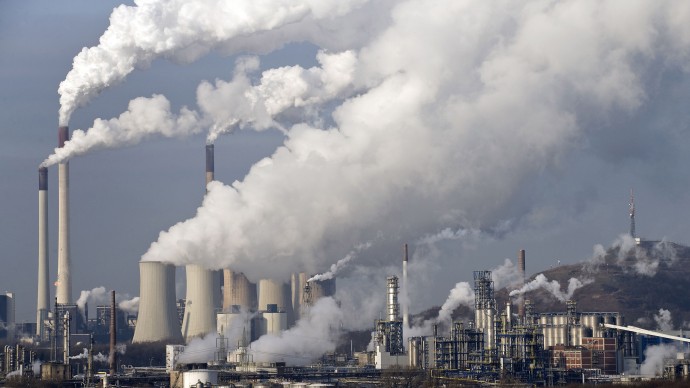
(MintPress)—U.S. corporations operating in the European Union (EU) are working a loophole in the carbon credit trading system that allows the purchase and sale of carbon credits banned by the European Commission, allowing companies to technically adhere to Kyoto Protocol standards while emitting an unlimited amount of greenhouse gases.
Key American corporations, such as Dow Chemical, Chevron, Cabot Corporation and ConocoPhillips, purchased a collective one million low cost carbon emissions reduction certificates (CERs) that flooded the EU carbon trading market through questionable create-and-destroy practices. The purchase of carbon credits is acceptable in the EU — a signatory to the Kyoto Protocol — as an alternative to reducing greenhouse gas emissions.
While the American corporations claim they were not aware of the ineffectiveness of such credits at the time, they admit they are now — and will still legally be able to purchase and trade such credits through 2013.
The credits were created by companies in developing countries that realized the value in creating HFC-23, a highly toxic carbon emission, for the sake of destroying it — a process that would allow them to cash in on the creation of CERs, which are generated through projects that can certify a reduction in greenhouse gas emissions. Credits are appointed through a United Nations’ governed Clean Development Mechanism (CDM) body.
Essentially, a large oil company can emit greenhouse gasses so long as they prove to invest in a developing company that’s implementing green practices.
Considering HFC-23 is known to be a super greenhouse gas nearly 12,000 times more harmful than regular greenhouse gas emissions, companies were able to obtain many credits for destruction and sell them at low costs, creating a popular source for U.S. companies operating in the EU, which already find it cheaper to purchase credits than reduce emissions.
Those against such practices claim the use of HFC-23 credits does not serve the purpose of the Kyoto Protocol, which was created to lower nations’ overall greenhouse gas emissions, not provide loopholes and avenues for profits generated through the creation and destruction of toxic emissions.
How are CERs created?
CERs are issued when a company can prove that a new project certifiably reduces greenhouse gas emissions, thereby allowing such credits to be traded in a public market.
According to CDM Watch, an independent organization aimed at ensuring that traded carbon emission credits are effective and verifiable, the HFC-23 trading scheme threw up a red flag on the carbon credit trading program.
“Although the Clean Development Mechanism (CDM) has mobilised thousands of projects over the past few years, the CDM has triggered serious concerns about the environmental integrity of its projects and its genuine contribution to sustainable development,” CDM Watch states on its website.
Banned, but still used
While the European Union has voted to ban the use of offset credits generated through questionable projects, the law will not go into effect until 2013, leaving companies with little incentive to trade in the dubious credits for sound CERs.
Considering companies know the time is running out for HFC-23 credits, markets are being flooded by those who want to get them off their hands, resulting in a supply-and-demand diminishing cost effect. According to the Inter Press Service, such credits went from $33 to its current rate of less than $6.
In a story published by the Inter Press Service, U.S. companies said they will continue to use the HFC-23 carbon credits as legitimate alternatives to greenhouse emission cutbacks until the ban officially takes effect in 2013.
“We have used such CERs for compliance in past years. We will remain fully compliant with the regulations, which means we will cease using the industrial gas CERs as of April 2013,” said Dow Public Affairs Officer Drea Berghorst.
Dow is not the only company — Chevon, Cabot Corporation and ConocoPhilips have all admitted to a policy of sticking with the controversial carbon credits until they cannot otherwise, regardless of the impact it would have on overall greenhouse gas emission combat.
Sean Comey, media advisor for Chevron told Inter Press Service that the company plans to comply with the Emissions Trading System in the EU, which means it will continue to use the HCF-23 credits through 2013. Chevron admitted to use the dubious credits to offset emissions at its United Kingdom offshore oil fields.
The same practices are being adopted by British Petroleum and British Shell, among others.
In a press release, EU Commissioner for Climate Change Connie Hedegaard expressed frustration with the carbon trading debacle, raising concerns that the situation could harm the credibility of the program.
“These projects raise concerns relating to their environmental integrity, value-for-money and geographical distribution,” she said.
Where did the ‘bad’ CER credits come from?
Companies, most notably in China, Japan and India, that create refrigeration supplies, generate HFC-23 as a byproduct, which they then destroy. In terms of its harm, HFC-28 is known as an extremely intense greenhouse gas, considered 11,700 times more harmful.
Many CERs were awarded through such projects, as they were seen as destroying extreme greenhouse gas emissions and therefore worthy of credit offsets. But there was a problem with this equation — providing credits for the destruction of such toxic emissions provided an incentive for industrial gas projects to create them.
The problem was addressed by CDM Watch, but in 2009, the CDM Executive Board issued 6 million credits — most of which went to two companies that were creating and destroying HFC-23.
The current ban implemented by the EU applies to use of CERs generated through projects that destroy HFC-23 and HFC-22.
Moving forward
Those frustrated with the exposed loophole argue that bans should be placed on companies immediately, forcing large corporations to buy legitimate carbon credits or reduce emissions. However, when the European Commission ruled in 2011 that they were to be banned, it allowed time for companies to adjust.
“The restrictions will apply from 1st May 2013, giving market participants sufficient time to adapt,” the press release stated.


